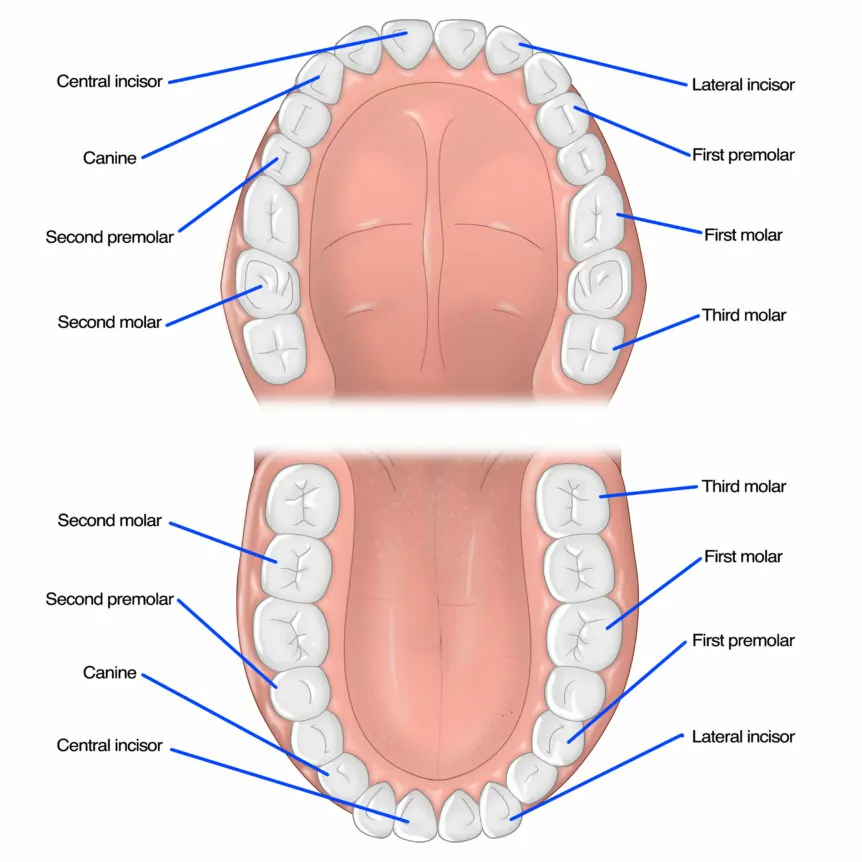There Are 32 Teeth in the Adult Mouth

While everyone on Earth has a mouth full of teeth, no one tends to give them much thought. Yes, they are aware that they must properly engage in good oral hygiene in order to prevent the development of oral diseases, but no one, outside of dental care professionals, really stops and thinks about teeth and their functions. You may only know that they help you eat. However, do you know about the different types of teeth and what they do?
Most children have only 20 teeth, known as primary or baby teeth, which begin to grow around the time an infant is six months old. All of them should have erupted by the time a child is 3. Between the ages of 6 and 12, these baby teeth will begin to fall out. During this phase, children will be leaving their teeth under their pillows for the tooth fairy, while they patiently wait for their adult teeth to grow in.
The majority of adults have 32 teeth, known as their permanent or secondary teeth. They have:
- 8 incisors
- 4 canines/cuspids
- 8 premolars/bicuspids
- 12 molars, which also include 4 wisdom teeth
By the time you turn 21, all of your permanent teeth will have grown in. While we just listed the different kinds of teeth, very few people truly know the difference between them and what they do. Cosmetic & Family Dentistry of Las Colinas is here to give you a better understanding of your teeth.
Different Types of Teeth
As we have already stated, most adults have 32 teeth. Some divide teeth into three different types: incisors, canines, and molars. However, many dental care experts like to distinguish between the three types of molars: premolars, molars, and third molars, also known as wisdom teeth.
Today, we are going to be differentiating between these three molars, so in total, there will be five different types of teeth. Both the bottom and the top row of teeth comprise of 16 teeth, containing all types of teeth.
Incisors
The first teeth we are going to discuss are the incisors. They are the first group of teeth that grow in after your baby teeth fall out. They also make up the majority of your smile, often being referred to as the anterior or front teeth. There is a total of eight incisors in your mouth; four in the top-center of your mouth and four in the bottom-center.
Incisors are typically thin and flat and look like small chisels. They are fairly sharp, which allows them to help you bite into your food. Their narrow edge has adapted perfectly to cut your food. Your incisors are what makes the initial bite into food.
Canines/Cuspids
Arguably the most distinct teeth in your mouth are your canines, also referred to as cuspids. They are the closest link between human mouths and the mouths of carnivorous predators like wolves and lions. In pop culture, creatures like vampires have extremely pronounced canines. In typical humans, canines are much smaller. However, they are still the longest teeth in the human mouth, with one pointed end and one long, single root.
There are two canines on the bottom and top of your mouth. They reside on both sides of your four incisor teeth. Their main purpose is to tear into food and rip it apart, but they also help guide your mouth into the best biting position.
They typically arrive right after your incisors, with the bottom canines erupting before the top ones.
Premolars/Bicuspids
Immediately following your canines are your premolars. Premolars are also referred to as your bicuspids. These are the foremost molars in your mouth. In total, there are eight premolars with four on the top of your mouth and four on the bottom. Behind each canine on both sides of the top and bottom row of teeth sit two bicuspids.
Premolars are far bigger than canines and incisors. Unlike those two, premolars have flat surfaces with three to four cusps, which allow them to properly crush and grind your food into smaller pieces, making it easier to swallow.
Molars
Your molars are the strongest teeth in your mouth. They are the main masticators, which means they are the teeth most commonly used for chewing. They are found the furthest in your mouth. Molars are broader than premolars and possess four to five cusps.
When you chew, your tongue naturally pushes food to the back of the mouth. There, your molars’ broad, flat surfaces allow them to properly break up your food for easy swallowing. You have a total of 12 molars. There are six on the top of your mouth and six on the bottom, with three on each side. However, it’s important to remember that four of these molars are also known as your third molars or, as they are better known, your wisdom teeth.
- Wisdom Teeth: Third molars are the last teeth to come into your mouth. While not everyone grows wisdom teeth, for the ones that do, their mouths don’t always have enough room for them. Unfortunately, this leads to wisdom teeth being impacted, meaning they are stuck under the gums. The best way to diagnose impacted wisdom teeth is through dental x-rays. Impacted teeth cause a great deal of pain and discomfort, sometimes even leading to infections or diseases. The only way to treat this condition is by extracting the teeth.
The Bottom Line
There are different types of teeth in your mouth. While they each have separate purposes on their own, they all share the same goals. They exist to help you eat properly, biting into your food and breaking it up, so it’s safe to swallow. Your teeth also play a large role in how you speak. They help you properly enunciate certain sounds to create words.
Your teeth are incredibly strong, but they don’t last forever. You have to take proper care of them. This means you must brush twice a day and floss daily. That also means you should regularly receive a dental cleaning at least twice a year. If you are interested in learning more about taking better care of your teeth or need to schedule your next cleaning, contact Cosmetic & Family Dentistry of Las Colinas today.
- Awareness16
- Bad Breath1
- Bone Grafting1
- Braces4
- Causes, Symptoms, And Treatments6
- Cavities5
- Chewing Gum1
- Cosmetic Dentistry of Las Colinas15
- COVID-192
- Deep Cleaning7
- Dental Anxiety1
- Dental Bridge2
- Dental Care27
- Dental Cleaning6
- Dental Crown1
- Dental Filling1
- Dental Health24
- Dental Implants6
- Dental Sedation1
- Dental Visit1
- Dental X Ray3
- Floss1
- Gum Dieseases4
- Injury1
- Insurance1
- Invisalign8
- Oral Cancer1
- Oral Hygiene24
- Root Canal9
- Sleep Apnea2
- Tartar1
- Teeth19
- Thanksgiving1
- TMJ1
- Tongue1
- Veneers2
- White Teeth12
Get Your Best Smile With Us
